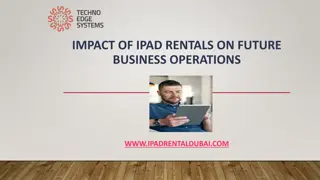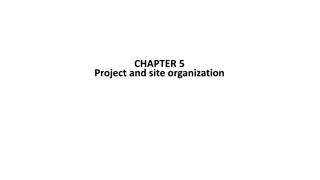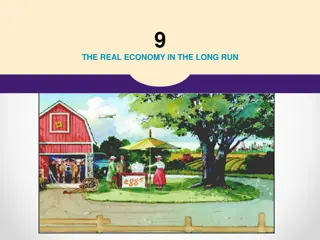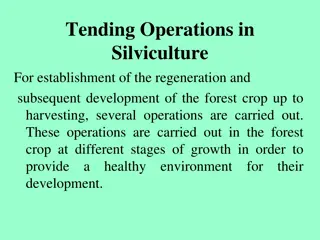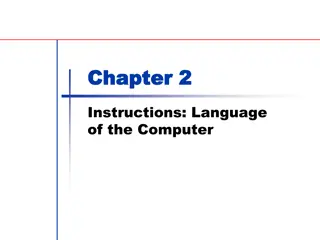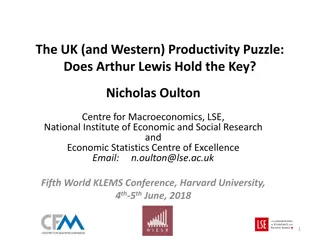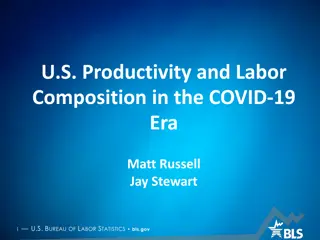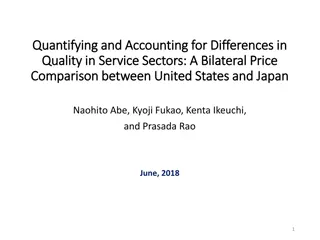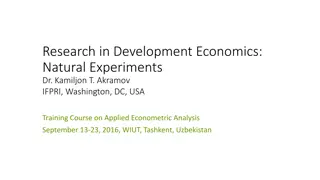Enhancing Operations Productivity: Strategies and Impact
Explore the significance of operations management through insights on strategic decisions, productivity improvements at Starbucks, and the role of productivity in enhancing overall effectiveness. Learn about key aspects such as design, quality management, supply chain, and more, and how operational enhancements can lead to revenue growth and improved efficiency in various industries.
Uploaded on Sep 28, 2024 | 3 Views
Download Presentation

Please find below an Image/Link to download the presentation.
The content on the website is provided AS IS for your information and personal use only. It may not be sold, licensed, or shared on other websites without obtaining consent from the author.If you encounter any issues during the download, it is possible that the publisher has removed the file from their server.
You are allowed to download the files provided on this website for personal or commercial use, subject to the condition that they are used lawfully. All files are the property of their respective owners.
The content on the website is provided AS IS for your information and personal use only. It may not be sold, licensed, or shared on other websites without obtaining consent from the author.
E N D
Presentation Transcript
Operations Operations Your Professor: Dr. Justin Bateh www.drjustinbateh.com
Who are you? Name Major / Graduation date Occupation (if any) Why is operations important? Experience in operations?
Operations Management who cares? Why study it? Revenue first, organization later - View of operations now compared to the past Chief Operating Officer (#2) vs. Chief Executive Officer (#1) which one are you? The job market in operations Technology/methods Facilities/space utilization Strategic issues Response time People/team development Customer service Quality Cost reduction Inventory reduction Productivity improvement Source, Make, Deliver, Return
Ten Strategic Decisions (handout) 1. Design of goods and services 2. Managing quality 3. Process and capacity design 4. Location strategy 5. Layout strategy 6. Human resources and job design 7. Supply-chain management 8. Inventory management 9. Scheduling 10. Maintenance Frito-Lay Video
Improving Productivity at Starbucks A team of 10 analysts continually look for ways to shave time. Some improvements: Stop requiring signatures on credit card purchases under $25 Saved 8 seconds per transaction Change the size of the ice scoop New espresso machines Saved 14 seconds per drink Saved 12 seconds per shot
Improving Productivity at Starbucks A team of 10 analysts continually look for ways to shave time. Some improvements: Operations improvements have helped Starbucks increase yearly revenue per outlet by $250,000 to $1,000,000. Productivity has improved by 27%, or about 4.5% per year. Stop requiring signatures on credit card purchases under $25 Saved 8 seconds per transaction Change the size of the ice scoop New espresso machines Saved 14 seconds per drink Saved 12 seconds per shot
Productivity (printout) Units produced Input used Productivity = Measure of process improvement Represents output relative to input Only through productivity increases can our standard of living improve Benchmarking!
Productivity Calculations (printout) Labor Productivity Units produced Labor-hours used Productivity = 1,000 = = 4units/labor-hour 250 One resource input single-factor productivity
Multi-Factor Productivity (printout) Output Productivity = Labor + Material + Energy + Capital + Miscellaneous Also known as total factor productivity Output and inputs are often expressed in dollars Multiple resource inputs multi-factor productivity
Productivity and the Service Sector 1. Typically labor intensive 2. Frequently focused on unique individual attributes or desires 3. Often an intellectual task performed by professionals 4. Often difficult to mechanize and automate 5. Often difficult to evaluate for quality
Activity: Labor Productivity Labor productivity is sometimes perceived to be driven by employee motivation. 1. Split up into small groups to discuss effective ways to motivate hourly employees vs. salaried managers. If productivity of these workers is below expectation, what are good and poor ways to try to motivate them? What methods might work well with blue collar employees but not white collar employees, and vice versa? What methods might work well in the short run but not in the long run, and vice versa? 2. Each group reports its ideas to the whole class. (And if any group has little to say, what could have been done to motivate yourself to do better!)
What do we look for in operations? Improvements: Revised the menu Designed meals for easy preparation Shifted some preparation to suppliers Efficient layout and automation Training and employee empowerment New water and energy saving grills
Productivity at Taco Bell Preparation time cut to 8 seconds Management span of control increased from 5 to 30 In-store labor cut by 15 hours/day Floor space reduced by more than 50% Stores average 164 seconds/customer from drive-up to pull-out Water- and energy-savings grills conserve 300 million gallons of water and 200 million KwH of electricity each year Green-inspired cooking method saves 5,800 restaurants $17 million per year Results: Improvements:
Current Challenges in OM Globalization Supply-chain partnering Sustainability Rapid product development Mass customization Lean operations
Operations Management and Hard Rock Cafe Video What aspects of the decisions are unique to service businesses in general and then to Hard Rock Cafe in particular? Two clear differences about Hard Rock Cafe itself are (1) because of and contributing to such successful branding, the cafe s retail sales (shirts, etc.) account for nearly the same amount of revenue as the main product (the food) itself; and (2) the management of the memorabilia around the world represents a unique and extremely important management effort on its own.
Operations Strategy in a Global Environment Reasons to Globalize 1.Improve the supply chain 2.Reduce costs (labor, taxes, tariffs, etc.) 3.Improve operations 4.Understand markets 5.Improve products 6.Attract and retain global talent Video: Hard Rock Caf s Global Strategy Class: What considerations should companies make when deciding to go global?
Improve the Supply Chain Locating facilities closer to unique resources Auto design to California Athletic shoe production to China Perfume manufacturing in France
Companies Want To Consider National literacy rate Rate of innovation Rate of technology change Number of skilled workers Political stability Product liability laws Export restrictions Variations in language Work ethic Tax rates Inflation Availability of raw materials Interest rates Population Number of miles of highway Phone system
Strategies for Competitive Advantage 1. Differentiation better, or at least different 2. Cost leadership cheaper 3. Response more responsive
Competing on Differentiation Uniqueness can go beyond both the physical characteristics and service attributes to encompass everything that impacts customer's perception of value Safeskin gloves leading edge products Walt Disney Magic Kingdom experience differentiation Hard Rock Cafe dining experience
Experience Differentiation Engaging a customer with a product through imaginative use of the five senses, so the customer experiences the product Theme parks use sight, sound, smell, and participation Movie theatres use sight, sound, moving seats, smells, and mists of rain Restaurants use music, smell, and open kitchens
Competing on Cost Provide the maximum value as perceived by customer. Does not imply low quality. Southwest Airlines secondary airports, no frills service, efficient utilization of equipment Walmart small overhead, shrinkage, and distribution costs
OM IN PRACTICE: IKEA OM IN PRACTICE: IKEA IKEA, a global home furnishings company, offers functional and smartly designed products at prices perceived by customers to be good values. Cost is a central focus at IKEA, from design to distribution. One of the company s key operational decisions was to keep prices low by designing furniture that customers can assemble themselves. Items are shipped unassembled in flat-pack boxes to reduce shipping, storage, and distribution costs. Furniture is designed to be modular so that components can be manufactured at low-cost sites around the world. New furniture designs must comply with standards for modularity, self-assembly, and cost in order to be included in the company s offerings. Long-term contracts and flexible production requirements are in place with suppliers to secure preferred pricing. To further cut overhead costs, the company s stores and warehouses are designed to be extremely energy efficient. IKEA has turned its operations into a strategic competitive advantage by learning. By effectively managing every aspect of its operations in a way that keeps costs low without sacrificing quality and design, IKEA competes both on cost and on differentiation (in providing perceived value and product quality). This grants it a competitive advantage, which in turn has made it successful. As a company, IKEA has learned how to win in its industry and its sector.
Activity: Which strategy? Think about the accounting/tax advising industry. Think about managing a brand new firm trying to join the industry. What strategy should their firm follow? Each group should then try to convince the class why his or her strategy is best. Class - which strategy seems to dominate?
Risks of Outsourcing TABLE 2.2 Potential Advantages and Disadvantages of Outsourcing ADVANTAGES DISADVANTAGES Cost savings Increased logistics and inventory costs Gaining outside expertise Loss of control (quality, delivery, etc.) Improving operations and service Potential creation of future competition Maintaining a focus on core competencies Negative impact on employees Accessing outside technology Risks may not manifest themselves for years
Class Discussion Some students may feel that outsourcing simply should not occur because it is unethical to lay off productive and loyal workers just to save some money. Questions: What if it was your job (or your parent s job) being outsourced? In reference to U.S. manufacturing, the textile industry is one of the first industries that moved out of the U.S. Why did the U.S. lose this industry to other, less developed countries, primarily China and other Asian countries? When did this happen? Was it primarily because of cheap labor rates?




